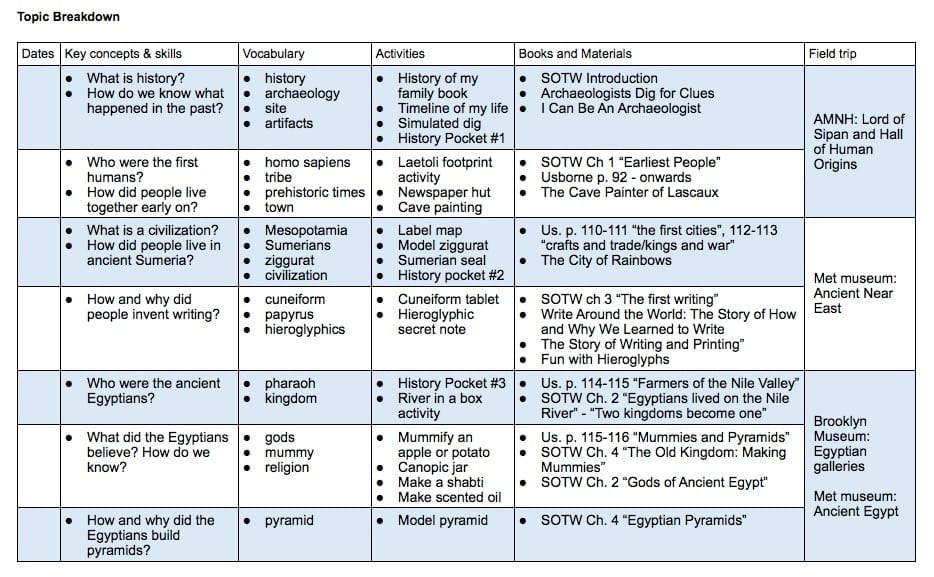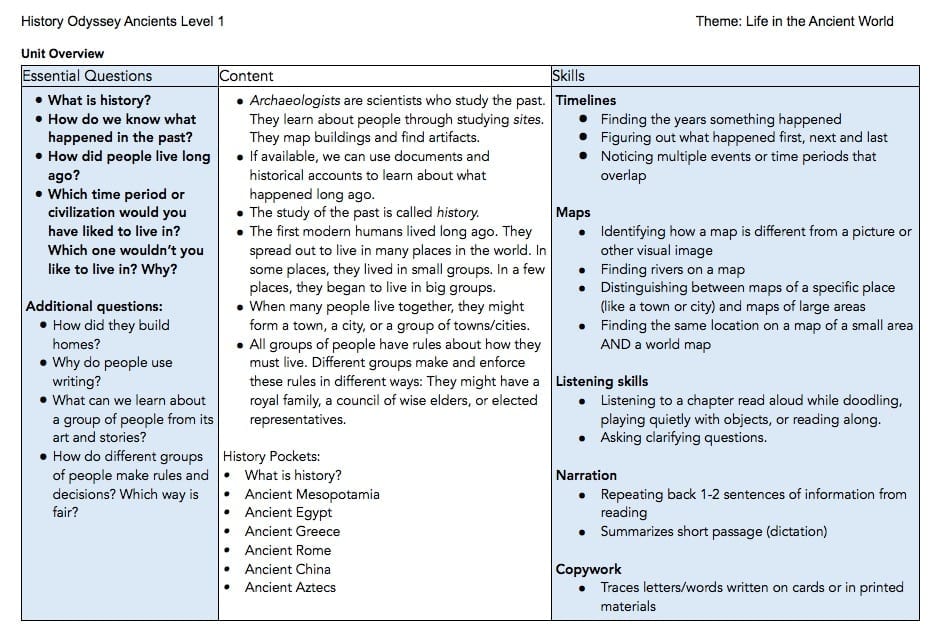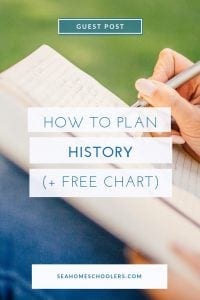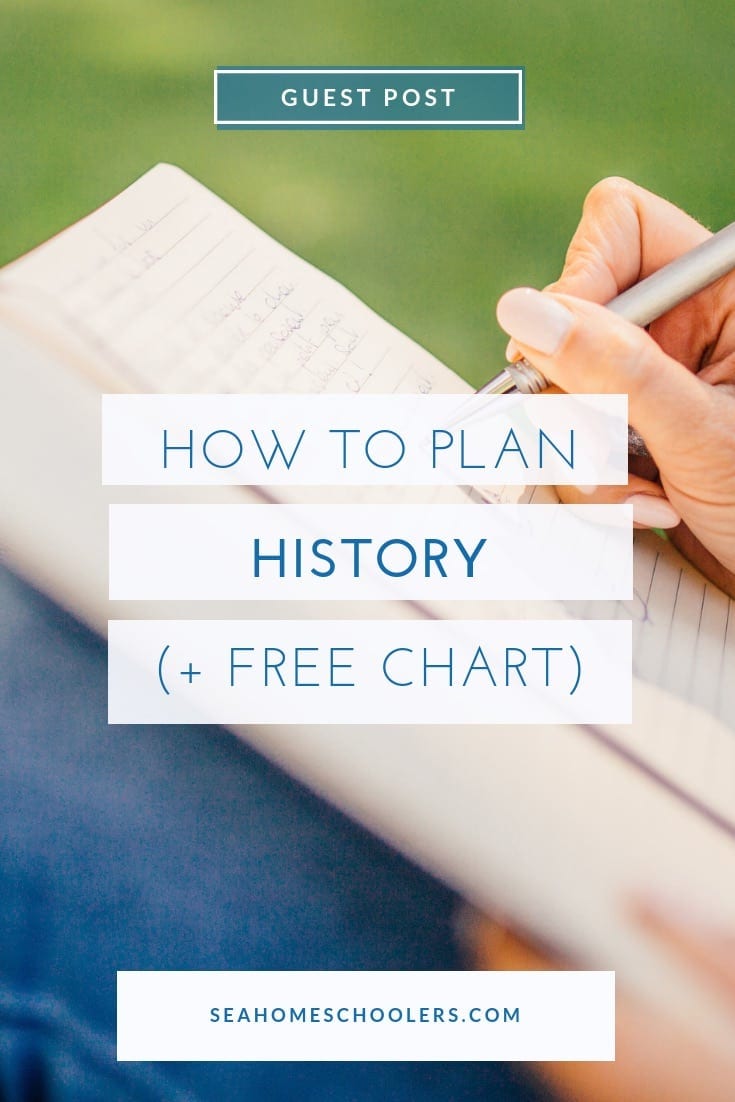Homeschool History: How To Plan It
Are you thinking about how to homeschool history? Particularly if you are just starting out, it can seem like there are too many choices. Should you start with American history, or go chronologically? Should you buy a structured program or build your own, based off your child’s interests?
I’ll be breaking down how to make decisions about history for your homeschool, and sharing my planning process along the way.
My overall process for planning out history curriculum:
Here are the general steps to follow in planning out your history study:
- Choose a method for organizing history study.
- Decide how much time you will devote to your history study.
- Choose a curriculum or set of resources.
- Plan out how you will implement and shape the program to meet your family’s needs.
- Try it out, and adjust as you go along.
Choose a method for organizing history study.
Part of what makes history overwhelming (but fascinating and worthwhile) is that there is so much of it! And more accumulating every day! How do you make it manageable? Is it possible to “cover everything”? Should that even be the goal?
Here are three common approaches to organizing a historical study.
State standards
Depending on where you live, there may be specific requirements to follow. If you plan to send your child to public school in the future, or are required by your state’s homeschooling laws to cover certain topics, you may want to adhere to your state standards. This doesn’t mean you have to use the state’s textbook or cover topics in the same style! You can still customize the experience.
Many states start with the child’s immediate surroundings, gradually widening the circle. Such a sequence might look like this for an elementary student:
- Kindergarten: All about me
- 1st grade: My family and other families
- 2nd grade: My community and other US communities
- 3rd grade: Communities around the world
- 4th grade: My state’s history
You may find that this sequence works for your child, even if your state doesn’t require it. Or you may find it limiting. You can add in more than what your state requires, or choose an entirely different approach – as you’ll see below.
Classical approach
The idea behind the classical approach is that children study history chronologically. The first four years introduce the four time periods – ancient, medieval, early modern, and modern. This first time around, they are simply gathering information and familiarizing themselves with background knowledge. In 5th-8th grade and high school, the classical history model cycles through all four time periods two more times, with increasing complexity and depth.
The classical approach’s repetition means, theoretically, that your child’s entire history curriculum is mapped out from 1st-12th grade. However, choosing this approach doesn’t mean that your planning work is done! You can also hop on the classical train even if your child “missed” the first stop. There are ways to restructure, speed up, or slow down the sequence to accommodate your child.
Unit studies of selected topics and time periods
Another popular approach is to select topics or time periods based on your child’s interests. This is how I prefer to study history for myself, as an adult. I find interesting topics or people and learn all I can about them. Then I follow my interest to the next topic.
You can turn almost anything into a rich historical study. It might be the history of video games, or ancient Egypt, or fashion, or trains. Your child’s favorite subject can serve as a “lens” through which history comes into focus.
In some ways, this is the easiest approach, because your child will be interested in whatever you plan. But this can also feel piecemeal or disjointed, particularly as your child’s interests shift over time. It also puts more onus on you to find resources, and makes it less likely that you will be able to buy curriculum. Instead, you’ll be on your own – which might feel freeing, or terrifying. Or both!
So which one is best?
It depends on you and your family! I’ll share the reasons I made the choice I did, but the beauty of homeschooling is that you can tailor your decisions to your own situation. You also don’t have to commit to one method forever. For example, you can follow your child’s interests during the elementary years, then switch to a more chronological approach later.
My choice: The classical approach
When I first heard that some young students learn about ancient and medieval civilizations and cultures, I thought it sounded nutty. I was skeptical that a young child would be interested in, or retain anything about, ancient history.
I became a convert thanks to my son’s fanatical devotion to the Magic Tree House series. He discovered them at age four and a half, and within six months, we read all 30 of the historical tales together!
Each tale provided a nice reference point and introduced some familiar names that my son could remember. The only frustration was that the books jumped around so much – from one place to another, and from one time period to another. I thought, “We should do this more systematically.”
So, I started thinking seriously about the classical approach. Here’s what I like about it:
- It provides an organization that makes sense. Going chronologically, and not jumping around, minimizes the chances that my son will get confused or miss connections.
- It decenters American history. American history is important, but overemphasized in many schools. Not to mention taught in isolation, apart from its European roots. 400 years of colonization and expansion are also given much greater attention than the thousands of years of native civilizations in the Americas. Expanding the focus to include indigenous societies is more accurate, as well as more fair.
- The structure eliminates worry about “missing something”. My son won’t remember every name or detail about the topics we cover, but we’ll have a framework to refer back to when he gets older. I like to think of the repeating timeline as our travel itinerary, off which we can take interesting side trips.
- We don’t need to follow state standards. For two reasons: we don’t live in a state that requires it, and the standards don’t provide a good historical foundation in the elementary years. As a homeschooled child, my son doesn’t need to spend a year studying “my family” or “my community”; he is immersed in it all the time!
So, you’ve decided what overall approach to take for the foreseeable future (state standards, classical approach, or unit studies). Now what?
Choose a curriculum or set of resources.
This will depend on the approach that you follow. You might buy a curriculum, or a good “spine” like the Usborne Encyclopedia of World History.
If you purchase a curriculum, don’t feel like you’re marrying it. Try it, then evaluate how well it works for you. There’s no obligation to slog through something you hate! Curriculum should be of service to you, not the other way around.
For this year, I chose History Odyssey Ancients 1 from Pandia Press. It met my requirements: secular, easily adaptable, and great book and project suggestions. (Note: The current version of this curriculum does use Story of the World, which is not strictly secular. However, the company is working on its own spine to replace SOTW in future editions. I checked out SOTW from the library so I could read secular snippets from it, but I plan to replace it when a new resource becomes available.)
Plan out how you will implement.
Even if your chosen curriculum markets itself as “open and go”, what are the chances that it will be perfect for your child right out of the box? Very slim. One size does not fit all! Here are the next steps to get you ready for diving in.
Gather up and examine the materials.
Start by gathering information and resources. Get the “lay of the land”. Figure out what books you’ll need, what projects to do, what vocabulary is introduced, and so on.
Many programs recommend a variety of resources, which you might buy new, buy used, or check out from the library. My local system can get almost any resource through interlibrary loan. This means I must leave ample time to put in requests and wait for books.
I examine each book to make sure the content is secular, the language and pictures are developmentally appropriate, and the content isn’t either whitewashed or gratuitously gory.
I do recommend scanning the curriculum in advance for any hard-to-find items. But don’t feel like you have to buy All The Craft Things right away. I tend to buy materials for projects close to when we need them. I don’t want tons of supplies sitting around the house, or the hassle of returning unused products if we decide to skip that project.
Check out this post by Sam Cook about choosing relevant topics.
Decide how much time you will devote to your history study.
- How much time will you and your child(ren) spend during any given session?
- How many days per week will you schedule history time?
- Will you include history in a loop with other topics, or assign it to specific dates and times?
Your choices will depend on factors unique to your family: the age of your child, the other subjects you’re doing, your child’s learning needs and preferences, time commitments, and so on.
My target is to spend about one month per “big topic”. The first month will be an introduction to what history is, reading from the suggested books, creating our first history pocket, setting up our timeline, excavating an archaeological “dig in a box”, visiting a museum, and making our own “artifacts”. After that, we’ll spend about a month on early humans, followed by our first civilizations.
I’m setting vague time parameters for now. Down the road, we may find that scheduling needs to be more formal. But in the scheme of things, it doesn’t matter how long our study takes. It’s not a race! We might decide to take it slow and stretch the curriculum out into a second year. Or, if my son is eager to get on with medieval, we might pick up the pace.
I’ll cycle back to this question in a few months, once we’ve had time to get into a routine.
Planning in practical terms:
To keep track of everything, I created a chart. It has a row for each major topic, rather than a weekly or daily format. I put in key concepts, vocabulary, activities, books and materials, and field trip ideas. Most of these are from the curriculum I purchased. I plan to write in the dates as we go along, but could easily put in target dates instead.

I did this for two reasons. One was to have it all on one page for easy reference, instead of continually flipping through my curriculum binder. The other was to make a few changes that I thought would meet my child’s needs better, like spending longer on “what is history?” and “the first humans”.
I also created a page to lay out big goals – concepts, skills, and questions we will be tackling throughout the year. Like “learning to read a map”, which isn’t a one-and-done activity. Your curriculum might provide this already made for you. Since mine didn’t, I added it.

You may find that you don’t need to write everything out, or don’t have time. That’s OK! But if you’d like to use my format for your own plans, you can get it free here.
If you’re planning by the week or day, you may want to use a teacher planner. Or, you can use my format but put in individual dates and times.
Try it out, and adjust as you go along.
Planning is a cyclical process. As you get started, you’ll learn what works and what doesn’t. I recommend planning with a light touch, knowing that things may change and leaving room for fresh ideas.


